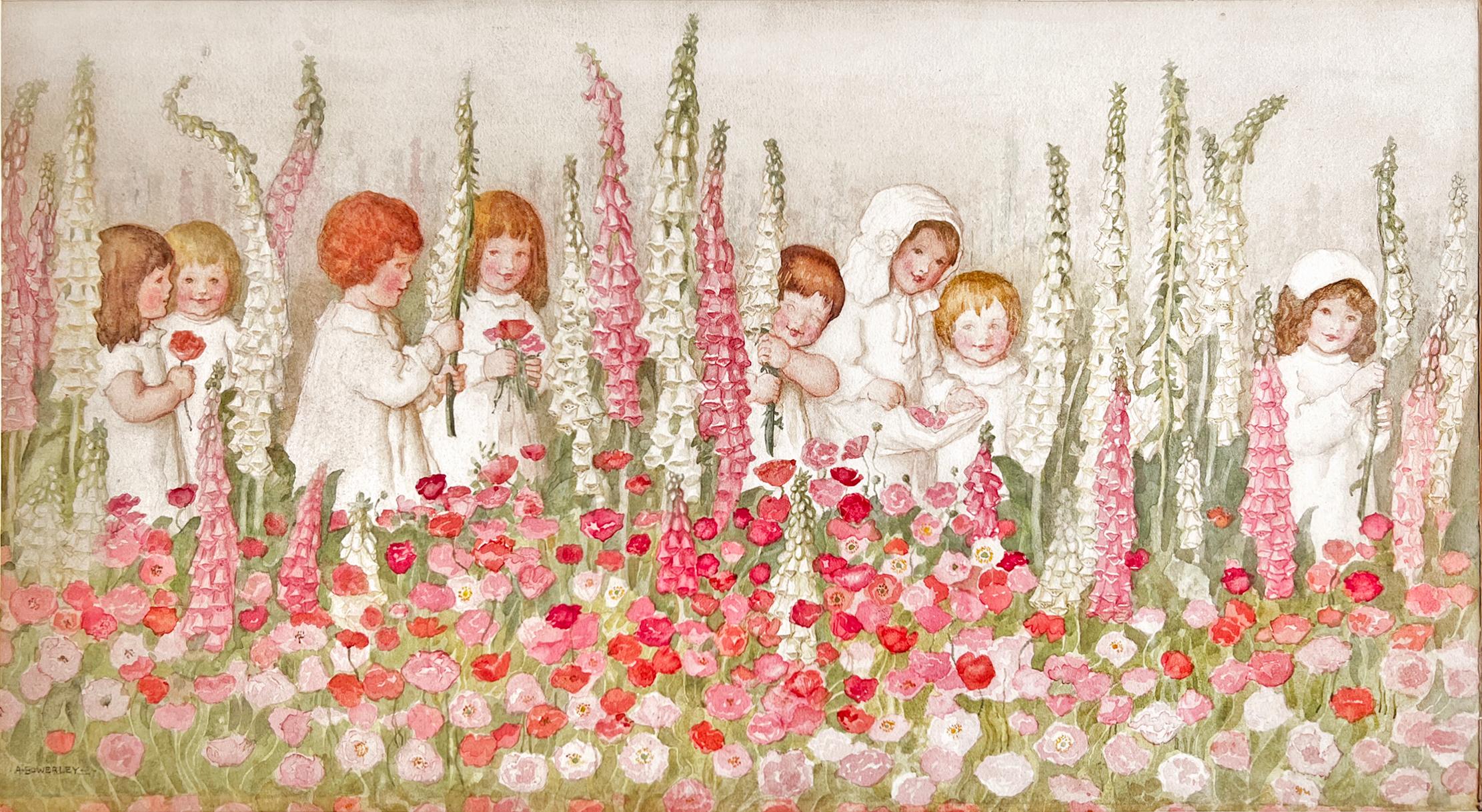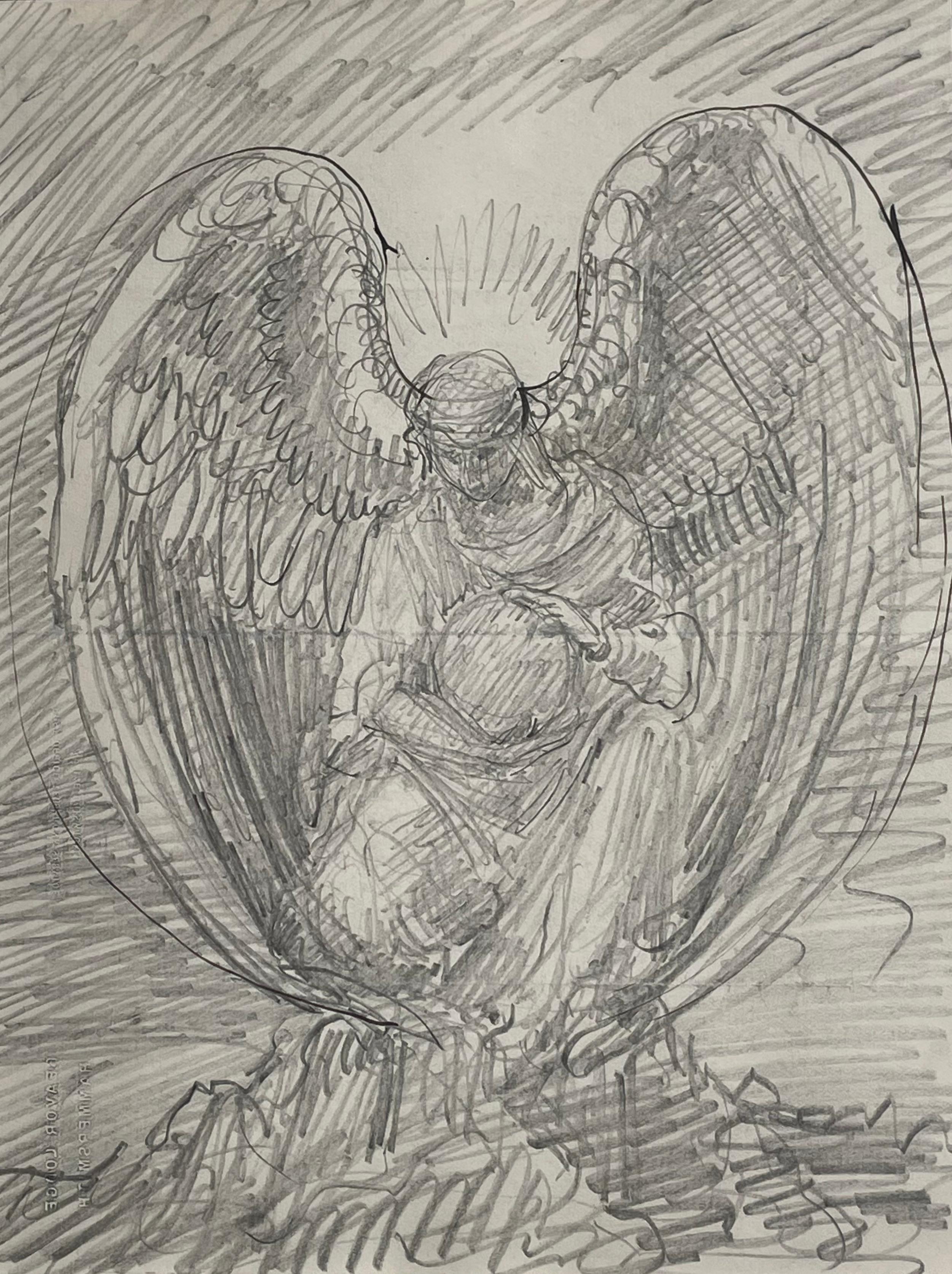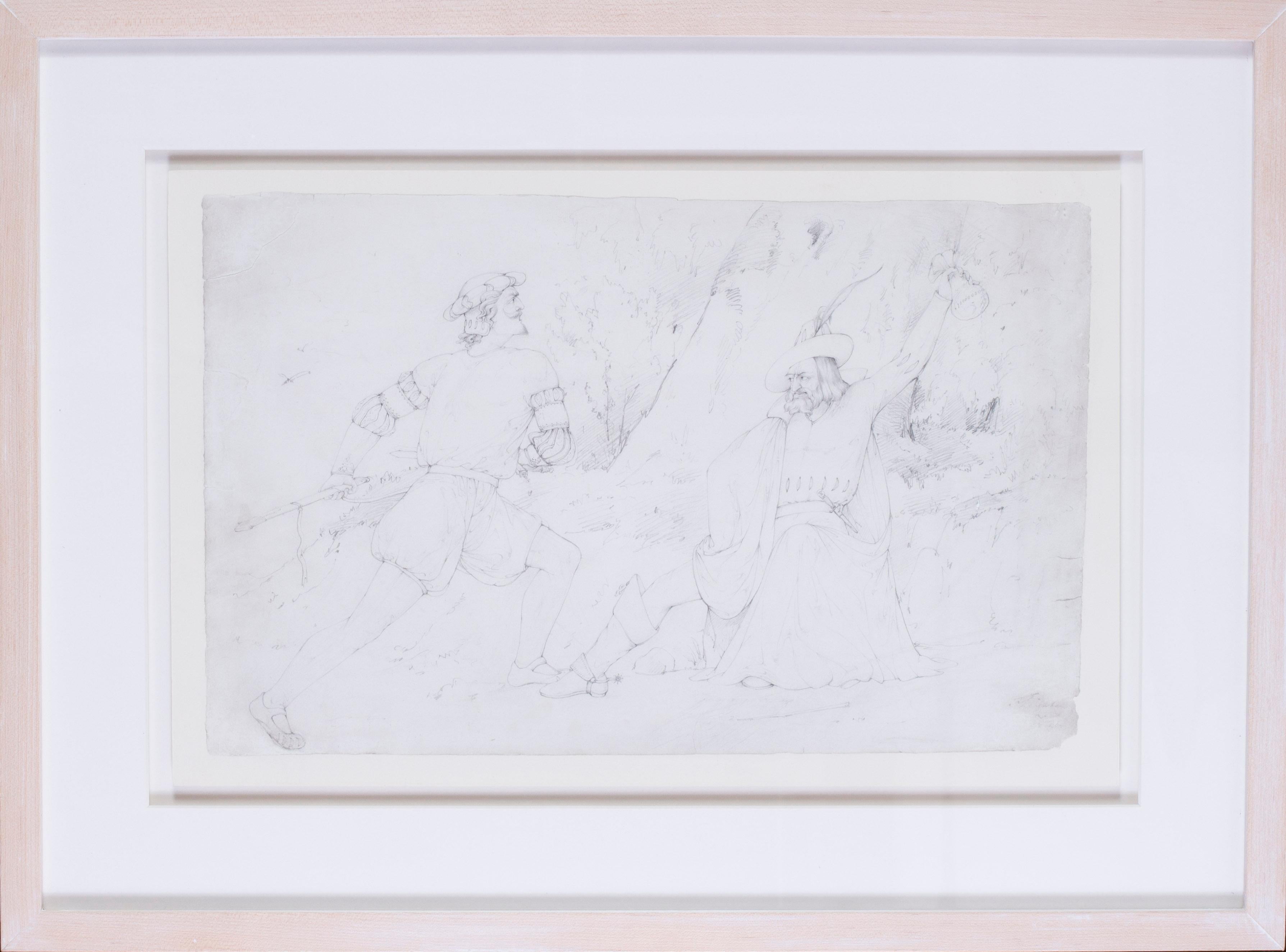Items Similar to Studies for a historic scene painting
Want more images or videos?
Request additional images or videos from the seller
1 of 9
Daniel MacliseStudies for a historic scene paintingn.d.
n.d.
About the Item
Studies for a historic scene painting
Graphite on paper, c. 1860's
Sheet size: 12 3/8 x 19 inches
Unsigned
Provenance: J S Maas & Co., London (see label)
Denys Sutton, London, noted art historian and scholar
Christie's (label)
Exhibited: J.S. Mass & Co. Ltd., Bond Street, London
Note: Maclise, an Irishman, was well regarded in London art circles. He is best known for historical scenes and series of murals that he executed in Westminster Palace. The studies on this sheet are typical of the romantic, almost Pre-Raphaelite imagery of the times.
Daniel Maclise RA (25 January 1806 – 25 April 1870) was an Irish history painter, literary and portrait painter, and illustrator, who worked for most of his life in London, England.
Early life
Maclise was born in Cork, Ireland, the son of Alexander McLish (also known as McLeish, McLish, McClisse or McLise), a tanner or shoemaker, but formerly a Scottish Highlander soldier. His education was of the plainest kind, but he was eager for culture, fond of reading, and anxious to become an artist. His father, however, placed him in employment, in 1820, in Newenham's Bank, where he remained for two years, before leaving to study at the Cork School of Art. In 1825 it happened that Sir Walter Scott was travelling in Ireland, and young Maclise, having seen him in a bookseller's shop, made a surreptitious sketch of the great man, which he afterwards lithographed. It became very popular, and led to many commissions for portraits, which he executed, in pencil.
Various influential friends recognised Maclise's genius and promise, and were anxious to furnish him with the means of studying in London; but refusing all financial assistance, he saved the money himself and arrived in the capital on 18 July 1827. There he made a sketch of Charles John Kean, the actor, which, like his portrait of Scott, was lithographed and published, making the artist a considerable sum. He entered the Royal Academy schools in 1828, eventually being awarded the highest prizes open to students.
Career
Maclise exhibited for the first time at the Royal Academy in 1829. Gradually he began to confine himself more exclusively to subject and historical pictures, varied occasionally by portraits – such as those of Lord Campbell, novelist Letitia Landon, Dickens, and other of his literary friends. In 1833, he exhibited two pictures which greatly increased his reputation, and in 1835 the Chivalric Vow of the Ladies and the Peacock procured his election as associate of the Academy, of which he became full member in 1840. The years that followed were occupied with a long series of figure pictures, deriving their subjects from history and tradition and from the works of Shakespeare, Goldsmith and Le Sage.
He also designed illustrations for several of Dickens's Christmas books and other works. Between the years 1830 and 1836 he contributed to Fraser's Magazine, under the pseudonym of Alfred Croquis, a remarkable series of portraits of the literary and other celebrities of the time – character studies, etched or lithographed in outline, and touched more or less with the emphasis of the caricaturist, which were afterwards published as the Maclise Portrait Gallery (1871). During the rebuilding of the Houses of Parliament in London in 1834–1850 by Charles Barry, Maclise was commissioned in 1846 to paint murals in the House of Lords on such subjects as Justice and Chivalry.
In 1858, Maclise commenced one of the two great monumental works of his life, The Meeting of Wellington and Blücher after the Battle of Waterloo, on the walls of Westminster Palace. It was begun in fresco, a process which proved unmanageable. The artist wished to resign the task, but, encouraged by Prince Albert, he studied in Berlin the new method of water-glass painting, and carried out the subject and its companion, The Death of Nelson, in that medium, completing the latter painting in 1864.
Maclise's vast painting of The Marriage of Strongbow and Aoife (1854) hangs in the National Gallery of Ireland, Dublin. It portrays the marriage of the main Norman conqueror of Ireland "Strongbow" to the daughter of his Gaelic ally. By the grand staircase of Halifax Town Hall, which was completed in 1863, there is a wall painting by Maclise.
The intense application which he gave to these great historic works, and various circumstances connected with the commission, had a serious effect on the artist's health. He began to shun the company in which he formerly delighted, his old buoyancy of spirits was gone, and when, in 1865, the presidency of the Royal Academy was offered to him he declined the honour. He died of acute pneumonia on 25 April 1870 at his home 4 Cheyne Walk, Chelsea.
His works are distinguished by powerful intellectual and imaginative qualities, but, in the opinion of Monkhouse, a late Victorian critic, somewhat marred by harsh and dull colouring, by metallic hardness of surface and texture, and by frequent touches of the theatrical in the action and attitudes of the figures. His fame rests most securely on his two greatest works at Westminster.
A memoir of Maclise, by his friend William Justin O'Driscoll, was published in 1871.
Courtesy Wikipedia
- Creator:Daniel Maclise (1806-1870, British)
- Creation Year:n.d.
- Dimensions:Height: 12.375 in (31.44 cm)Width: 19 in (48.26 cm)
- Medium:
- Movement & Style:
- Period:
- Condition:
- Gallery Location:Fairlawn, OH
- Reference Number:
About the Seller
5.0
Recognized Seller
These prestigious sellers are industry leaders and represent the highest echelon for item quality and design.
Platinum Seller
These expertly vetted sellers are 1stDibs' most experienced sellers and are rated highest by our customers.
Established in 1978
1stDibs seller since 2013
718 sales on 1stDibs
Typical response time: 1 hour
Associations
International Fine Print Dealers Association
- ShippingRetrieving quote...Ships From: Fairlawn, OH
- Return PolicyA return for this item may be initiated within 10 days of delivery.
More From This SellerView All
- Head of a Deco Woman (recto) Standing Male Model (verso)By Paul H. WinchellLocated in Fairlawn, OHHead of a Deco Woman (recto) Standing Male Model (verso) Graphite on paper, 1925 Signed with the artist's initials "PW" and dated 1925 Created while the artist was studying at the ...Category
1920s Art Deco Figurative Drawings and Watercolors
MaterialsGraphite
- Study for Republic StandingBy Pierre-Roch VigneronLocated in Fairlawn, OHStudy for “Republic Standing” Graphite on calque tracking paper, c. 1848 Signed lower right corner: Vigneron Provenance: Shepherd Gallery, New York ...Category
1840s Romantic Figurative Drawings and Watercolors
MaterialsGraphite
- Head of a Deco Woman (recto) Standing Male Model (verso)By Paul H. WinchellLocated in Fairlawn, OHHead of a Deco Woman (recto) Standing Male Model (verso) Graphite on paper, 1925 Signed with the artist's initials "PW" and dated 1925 Created while the artist was studying at the ...Category
1920s Art Deco Figurative Drawings and Watercolors
MaterialsGraphite
- Untitled (Study for The Aerialists)By John Steuart CurryLocated in Fairlawn, OHUntitled (Study for The Aerialists) Graphite on paper, 1932 Signed lower right in pencil: "John Steuart Curry" Dated: 1932 in pencil Exhibited: Schroeder Romero & Shredder, NYC (label), Master Drawings, Oct. 13, 2011-Nov. 12, 2011 (see photo of label) Arkansas Arts Center (label), 44th Collector Show & Sale, Nov. 30-December 30, 2012, Offered at $22,000. (see photo of label) This drawing is closely related to a painting by Curry entitled The Aerialists, 1932, once in the Erskine Collection, Cedar Rapids, Iowa. It is part of a group of preliminary drawings and three finished paintings executed by Curry around 1932 which were based on The Flying Cadonas. The painting The Flying Cadonas is an icon of American art purchased by the Whitney Museum of Art and now on permanent exhibition. There are other know studies for these works, nos. 199 through 222 and in John Steuart Curry: Rural America, page 32 (Mongerson Wunderlich, Chicago, 1990. Provenance: Mrs. Kathleen Curry (artist’s widow), included in the estate schedule of works Treadway Toomey Auction, Oak Park, Illinois, 2009 Don Joint, New York An important American Regionalist drawing. Like Grant Wood and Thomas Hart Benton, John Steuart Curry was a major American scene painter of the 1930s. His subjects were taken from American history and his most famous mural, The Tragic Prelude...Category
1930s American Modern Figurative Drawings and Watercolors
MaterialsGraphite
- Volunteer Firemen, ProvincetownBy E. Ambrose WebsterLocated in Fairlawn, OHPreparatory drawing for Volunteer Firemen, Provincetown Graphite on paper, 1932 Initialed in pencil by the artist lower left: W Provenance: Estate of the artist, 1935 Georgianna Webs...Category
1930s Modern Figurative Drawings and Watercolors
MaterialsGraphite
- Road TripLocated in Fairlawn, OHSigned: Rudolf Lailson lower left Graphite, charcoal watercolor and pastelCategory
Early 2000s Contemporary Figurative Drawings and Watercolors
MaterialsGraphite
You May Also Like
- Death the Bride, Late 19th Century Pre-Raphaelite Graphite on PaperBy Thomas Cooper GotchLocated in London, GBThomas Cooper Gotch RBA RI 1854 - 1931 Death the Bride Graphite on paper Image size: 44 x 34 inches Pre Raphaelite Style frame The title of the painting comes from Shakespeare. It ...Category
Late 19th Century Pre-Raphaelite Figurative Drawings and Watercolors
MaterialsGraphite
- Children Amongst Foxgloves - Pink Flowers, Female Illustrator of The Golden AgeLocated in Miami, FLChildren Amongst Foxgloves - Female Illustrator of The Golden Age by a female illustrator of The Golden Age Watercolor on paper, signed 'A. Bowerley' lower left. 11 x 20 in. (sight)...Category
Early 1900s Pre-Raphaelite Figurative Drawings and Watercolors
MaterialsWatercolor, Paper, Pencil
- Sir William Blake Richmond - An Angel - 19th Century British DrawingBy Sir William Blake RichmondLocated in London, GBSIR WILLIAM BLAKE RICHMOND, RA (1842-1921) Study of an Angel Pencil Unframed, in mount only 18.5 by 10.5 cm., 7 ¼ by 4 ¼ in. (mount size 32 by 25 cm., 12 ½ by 10 in.) William Bl...Category
Late 19th Century Pre-Raphaelite Figurative Drawings and Watercolors
MaterialsPencil
- Study of an Angel by British Pre-Raphaelite artist Sir William Blake RichmondBy Sir William Blake RichmondLocated in London, GBSIR WILLIAM BLAKE RICHMOND, RA (1842-1921) Study of an Angel Pencil on the artist’s writing paper for Beavor Lodge, Hammersmith Unframed 22.5 by 17 cm., 9 by 6 ¾ in. (mount size ...Category
1890s Pre-Raphaelite Figurative Drawings and Watercolors
MaterialsPencil
- Lord Frederick Leighton drawing, British pre-Raphaelite, originalBy Frederic LeightonLocated in Petworth, West SussexLord Frederick Leighton (British, 1830-1896) Apprehending a thief pencil on paper the fragment measures approx. 17.1/3 x 11in. (44 x 28cm.) signed ‘F Leighton’ (lower right) Provenan...Category
19th Century Pre-Raphaelite Figurative Drawings and Watercolors
MaterialsPaper, Pencil
- Pre-Raphaelite, early 19th Century drawing by the British artist Lord LeightonBy Frederic LeightonLocated in Petworth, West SussexLord Frederick Leighton (British, 1830-1896) A Medieval Allegory pencil on paper the fragment measures approx. 19.1/2 x 13 in. (49.5 x 33 cm.) Provenance: Gifted by Leighton to his ...Category
19th Century Pre-Raphaelite Figurative Drawings and Watercolors
MaterialsPaper, Pencil
Recently Viewed
View AllMore Ways To Browse
Antique For
Antique Study
Scene Painting
London Scene
Scene 4
Father And Son Paintings
Sketch Scene
Royal Scene Painting
Mural Studies
Mural Study
Historic New England
Antique Shop Drawing
London Street Scene Painting
Water Glass Painting
Drawing Ireland
Battle Scene Paintings
Figural Painting Unsigned
Victorian House Drawing





